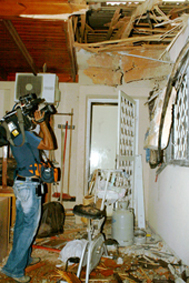You may have been wondering what the deal is with these rockets, because either the Israeli people are actually all invincible from birth, or these rockets are
 really not that great.
really not that great.Today, we'll have a closer look at what these rockets actually look like, how they work (or don't work), and why they're being used.
To your right you should see an image of the regular Qassam Rocket. Hamas paramilitary fighters are conveniently located next to each rocket to give you a sense of scale.
There are 3 broad types of Qassam Rockets (QR) varying in length from 2 ft 7 inches - 6 ft 7 inches (Just about the height of a regular doorway).
The body of the QR is a cylinder of regular grade steel, with guide vanes placed at the bottom for guidance. The nosecone and upper section are packed with as much explosives (TNT) as possible. The rocket motor is a solid fuel type using a mixture of sugar and fertilizer for fuel.
Below is a video of the QR in action (catchy music included!). Skip ahead to the 2:00 min mark to see construction process. You can see the rocket motor being installed, the sections being welded together and the solid fuel mixture being cast (that bit where they pour the orange liquid into a mould).
During the video keep an eye out for the corkscrew rocket contrails.
So, we can see that these rockets work because they're so incredibly simple. These rockets operate using the exact same principle as those model rockets you played with as a kid. The only difference is that your rocket probably didn't have an explosive payload. All you need to make these rockets yourself is some stock steel and a welding machine. Fertilizer and sugar can be picked up at your local hardware store and chemist.
But let's face it. These rockets just...suck.
 An image of a QR attack on a house in Sderot.
An image of a QR attack on a house in Sderot.Yup, that is in fact a butane/gas tank surrounded by flammable material, all very much un-exploded.
The Gaza rocket attacks started in 2001. The first Israeli fatality was in March 2007 . That's a pretty poor track record. The reason for this continued poor performance is twofold: 1) Construction techniques. There's only so much targeting you can do with an unguided missile. The most important part is lining up the guide vanes. Remember those corkscrew contrails I was talking about? When you see those, you know the guy who put the rocket together did a botch up job. Corkscrew's means the rocket is wasting energy in spinning around instead of using the energy to go further which means less range. It also means you can't aim the thing worth a damn, because where you point it is not necessarily where it is going to go.
2) It is not meant to inflict large amounts of damage. It's meant to terrorize people, and it is working. The people of Sderot (the primary target for these attacks) must hate those things with a passion.
Summary: The Qassam rockets are extremely easy to manufacture, require very little technical skill to operate and are largely ineffective in terms of physical destructive potential. Poor manufacturing technique further inhibits the ability of this rocket to be a real threat to a militarized nation such as Israel. The rockets are being used to terrorize the populace and to provoke a response out of the enemy government, which can later on be pointed to as further "proof" that the attacking nation is in fact the victim of an overzealous and aggressive neighbour. Underhanded, yet apparently effective, tactics.
No comments:
Post a Comment